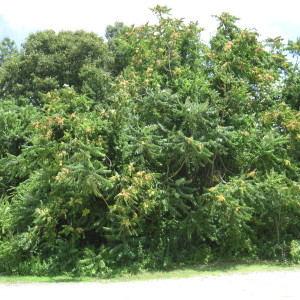Many of the trees we see growing on Long Island are highly invasive and non-native — commonly Chinese exotics brought here over 200 years ago. Today, most Long Island soils harbor viable seeds dispersed from their descendants via wind, birds, or mammals years to decades ago. Under the right circumstances — often sun exposure when land is cleared — these seeds will germinate and grow to out-compete native species.
Long Island’s invasive trees include the ubiquitous tree-of-heaven, Japanese angelica, Norway maple, and sycamore maple, plus some newcomers such as glossy buckthorn and Callery pear. Tree Control will address removing small seedlings and saplings — defined as young trees four inches or less in diameter at breast height. Larger tree removal may require a town permit and some trees may need treatment before cutting to prevent roots from sending out numerous sprouts.
Soon after removing tree seedlings and saplings, cover the open ground with mulch (a thick layer of leaves) or replace them with native, shade loving plants (plugs or seeds) such as white wood aster Eurybia divericata, and then mulch. This hardy, fast growing species is a beautiful shade loving weed suppressant. It self-seeds, blooms throughout September and is a source of nectar and pollen for native pollinators. Click Native Plants in Recent Posts:

Ailanthus altissima, tree-of-Heaven aka tree from hell, is very invasive. It is often confused in appearance with our native sumacs and black walnut. The trunk of tree-of-heaven is smooth (no ridges) and blotchy — resembling pig skin. However, the outstanding difference is the single “tooth” at the base on the otherwise smooth margin of the leaflets. Black walnut bark is deeply ridged and the leaflet margins are toothed.
The tree-of-heaven is dioecious — meaning trees are either male or female. Annually, the females can produce 300,000 or more wind dispersed seeds, which deposit on open ground and germinate by the hundreds or thousands in large patches for great distances downwind of the trees. The female can be recognized by the feathery-looking seed stems that remain at the crown of the tree through the fall, winter, and early spring after the seed pods (samaras) have dropped. Since the tree aggressively sprouts when cut, the trunk is often girdled to kill it a year or so prior to cutting down. Click Tree Control for ideas on removing seedlings/saplings.

Acer platanoides or Norway maple is similar in appearance to sugar maple. The easiest way to identify this tree is to break the leaf at the node where it joins the stem (petiole). You’ll notice white sap at the break, whereas saps from other maples are clear. Also, the point tips on Norway maple leaves have fine “hairs”, while the tips on other maple leaves are rounded.
The shallow roots of this species allow for simple removal of young trees and seedlings. See Tree Control.
